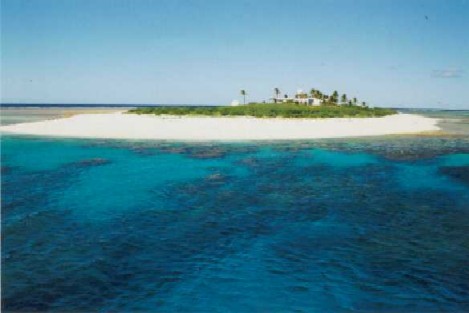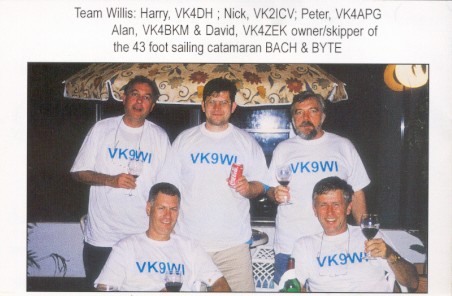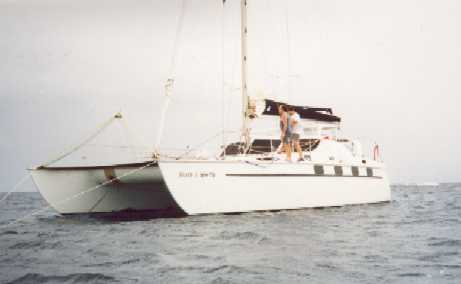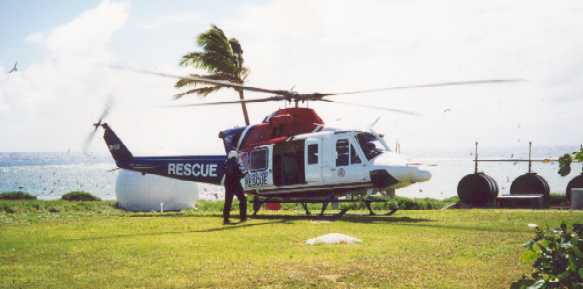
Despite the numerous amateur radio activations over the years by resident Officers of the Bureau of Meteorology (BOM) and several DXpeditions, Willis Island remains well up in the top 100 list of DXCC countries, especially for European operators.
Our decision to go to Willis was based on a number of reasons…
- We wanted somewhere reasonably close to Australia as a trial run for future DXpeditions,
- Willis was in the top 100 DXCC list,
- It was much easier than doing Mellish Reef first,
- and it sounded like a lot of fun…
Willis is a small coral Island in the Coral Sea of the North Australian coast, 250 Nautical Miles at bearing 82o True from Cairns, North Queensland. (Set your GPS waypoint to 16o 17.2’ S, 149o 57.4’ E. if you want to anchor off the island like we did. )

It’s a 15 acre Coral atoll formed by centuries of cyclones, measuring only 430m x 137m.
There are also 2 other atolls in the Willis group, approx 10 miles apart.
The Australian Government established a Bureau of Meteorology (BOM) station there in 1921 as a Cyclone early warning station. The station is now used for launching and Radar tracking of weather balloons as a key part of Australia’s contribution to world weather data collection.
Four full-time weather observers normally staff the facility, although at the time of our visit, there were only 3 present.
We decided to commit to going to Willis only in January this year. Transport was to be by my own boat, a 43’ cruising catamaran, launched in October 1999. The lists of tasks to be done seemed a little daunting at first, but it’s amazing what concerted effort and determination by a great team of people can achieve.
The timing for Willis was arranged to fit in with existing sailing commitments for the boat and crew. There is a yacht race at Easter each year from Brisbane, capital of Queensland, to Gladstone, an industrial port about 300 nautical miles North of Brisbane. Further yacht racing events followed up the central Queensland coast, so these served as a convenient means of moving the boat north with a sailing crew.
Most of the time and effort was spent in getting boat ready, both for the racing program, and for the Willis trip.
A website for the DXpedition was established (www.qsl.net/vk9wi), and this provided an excellent tool for distributing information and news of the coming trip. We soon had requests for activity on Willis from various special interest groups including 160 mtr, AO-10 satellite, EME, and even C.B.
Approaches were also made to a number of DX clubs and commercial organizations for sponsorship, some successfully and others particularly less so… But that’s another story.
Since this was to be our first DXpedition, we had no prior record of success, so I think there was doubt in some quarters as to whether we were serious.
In the initial discussions with the BOM,
it was proposed to only have a crew of 4 operators. We were required to be fully
self-sufficient, so that there was no load on the limited resources of the
Island staff.
Harry (VK4DH), and myself have been sailing together for over 30 years. While there is extensive sailing knowledge, neither of us had participated in a DXpedition before. Since the crew numbers were limited, it was essential that we find other operators with extensive DXpedition experience and skills.
Alan Meek - VK4BKM took a lot of convincing to come to Willis.
The conversation went something like –
“Alan, do you want to come to Willis with us?”
“Gee - I’ll have to think about it - - - OK.”
Nick VK2ICV (VK9LX) was a little harder to convince. He was concerned initially about going by sailing boat, as he had little experience with sailing. A quick trip to Brisbane for a days’ sailing on the boat soon convinced him though, so we had our team.
As planning progressed, we decided that, for safety, we should have one person on the boat at all times. After discussions with the BOM, the team was increased to 5 with Peter - VK4APG. Peter is a great friend, a 6 metre enthusiast, a superb cook, and a very experienced sailor, so we were more that pleased to have him join us.
 The
months leading up to Easter seemed to go past in a blur, with so many details to
arrange. Good Friday found us at the race start line in Moreton Bay, on time,
and raring to get going. The race to Gladstone is a story in itself, but I’ll
concentrate here on things affecting the radio aspects of the trip.
The
months leading up to Easter seemed to go past in a blur, with so many details to
arrange. Good Friday found us at the race start line in Moreton Bay, on time,
and raring to get going. The race to Gladstone is a story in itself, but I’ll
concentrate here on things affecting the radio aspects of the trip.
Following the Brisbane-Gladstone race, there was a series of races starting in Gladstone and going on to Yeppoon, on the central Queensland coast.
The weather during the Gladstone-Yeppoon race had deteriorated somewhat, with strong south-east winds, driving rain, and rough seas. Racing in Yeppoon was cancelled one day due to the strong winds. In the following race, we were pushing the boat rather hard when there was a crash, and 55’ of mast, rigging, and sails came down around us! Fortunately, no one was injured.
This was a major setback for the DXpedition, as new masts of this size usually take many weeks to manufacture, and we were due at Willis in less than 10 days.
I contacted the company which had built the mast for the boat and explained the urgency of our situation. I must compliment the management and staff from Allyacht Spars in Brisbane for their efforts in manufacturing the mast, transporting it 800 km north by road to Yeppoon, and re-rigging the boat, all in 8 days. Well done Allyachts!
The mast re-rigging meant that we had to leave for Willis from Yeppoon instead of further north as planned. This meant an extended voyage out to the island for the radio crew of 655 nm, (approx 1190 km). Nick VK2ICV flew up from Sydney into Brisbane instead, and helped us load the gear. For transport north from Brisbane to Yeppoon, we used a car, trailer, and a 1 tonne mini-van. When all was aboard, even some of the spare bunk space was used for the cartons of rigs and supplies.
When we departed Yeppoon, the winds were 20-25 knots from the southeast. At least they were taking us in the right direction. During the day however, the weather deteriorated, the wind strength increased to 30-35 knots, and the seas built to around 4 meters. Nick became less than well, and discussed how he felt with the fish on a few occasions.
We decided to take shelter behind South Percy Island until things improved. After 36 hours, the weather was showing signs of abating, and the forecast sounded promising, so we set off again for the passage out through the Great Barrier Reef, and on to Willis.
The Great Barrier Reef stretches for over 2000 km along the coat of Queensland. In the south, it is a broad scattering of individual reefs around 200 km out from the coast, but as you move north, the reef becomes denser and closer to the coast, until it forms almost a continuous barrier to the Coral Sea.
There are a number of navigable passages out through the reef, and modern GPS systems make these a relatively simple task. Once through the tide races and swells of the “Hydrographers Passage”, the trip became more relaxed. Nick actually started to enjoy the sailing, and his “sea-legs” improved.
Two things in particular made a great impression on me during the voyage. Firstly, what a lonely place the Coral Sea is… In the whole time we were outside the Barrier Reef, we did not sight another single ship… And the color of the water there has to be seen to be believed. It is the deepest and densest blue I have even seen.

Just after midnight on 13 May, we sighted the island lights of Willis, and gave them a call on the marine VHF. They were expecting us, and had been tracking our progress on the station’s weather radar from when we were 50 miles off. They gave us some advice on where to anchor off the island for the night, so we lowered sails and motored closer. By 1:30 am we were safely at anchor.
The first thing we noticed after the engine stopped was the noise of the birds from the Island several hundred metres away. The birds squawk all day, and all night.
Daylight brought our first real sight of our home for the next 10 days. We were struck by the sight of countless birds wheeling in the sky and the waves pounding on the exposed reef off to the south of us. The wind kept the boat’s wind generator at a constant whir, something only found in true tradewinds away from land.
But ah! The water! The colors were astounding.
We decided to move the boat into the downwind side of the island. This would provide some protection from the waves at high tide when the reef was covered, and the swell rolled almost uninterrupted past the island. We motored around to the north west end of Willis, and I chose what I thought looked like a sandy spot between patches of coral. The echo sounder seemed to be playing tricks with the depth, reading 5 metres and then 20, so we anchored over a “Sand spot”. The ceaseless wind and waves blurred the water surface, so we paid out the chain and dug the anchor in securely. The boat tugged ceaselessly on the chain in the 25 knot wind. I decided that a quick swim with a snorkel would let me see how the anchor was set, and the water was 26oC, warm and inviting.
Climbing down the stern ladder on the boat, I donned fins and goggles, and swam off. The view below the water surface was spectacular to say the least. I could see the 55 meters of anchor chain suspended off in mid water to the top of a distant coral bommie, and then the next bommie beyond that again! The water between the coral pillars was 20 meters deep, with fish swimming everywhere. So clear! The anchor was hooked onto a limestone boulder, so secure that I was concerned how we could eventually get it off.
Harry and I went ashore in the dinghy to meet Gary Malpass, one of the Met Officers who had walked down to the beach to meet us. We went up to the station and met Adam Gimes, the Technical officer, and the OIC, Rob Thompson, who gave us a tour of the establishment. Rob showed us where we could set up our gear with minimum inconvenience to them, so we returned to the boat to start unpacking.

We loaded the gear into the dinghy at low tide when the reef was exposed and the swells were less. First items ashore were fresh fruit and vegetables, medical supplies and mail which we’d brought from the mainland for the Willis staff.
Wheelbarrows borrowed from the station were used to ferry the gear up the track from the beach. We were careful not to disturb the gulls nesting everywhere, on the beach, and even right on the track, so we weaved between the nests.
Nick’s tribander for 20/ 15/ 10 was erected the first afternoon and set up with the FT920 and Nick’s Dentron linear. Unfortunately, a computer problem on his laptop later that day lost a chunk of detail of initial contacts. Great efforts were made to recover the file, but it was to no avail. Multiple file backups were made after that.
Our equipment list included
two Yaesu FT-920’s,
Yaesu FT847 for AO-10
Kenwood TS60 for 6 metres
Kenwood FL1000 linear,
Dentron Linear
Ameritron AL80B Linear (spare),
Antennas were a Battle Creek Special for 160/ 80/ 40,
Cushcraft Tribander for 20/15/10,
Cushcraft A3WS for the 30/ 18/ 12 WARC bands,
K6STI optimised 5 element yagi for 6 meters.
We also had brought 144 and 432 MHz beams and equipment for AO-10 operation, which due to subsequent events, we unfortunately could not get time to set up.
We operated on all bands from 160 to 6M, on CW and SSB, with RTTY on 40, 20,
During antenna erection, Harry tripped over a guy-wire peg and gashed his leg rather badly, which virtually immobilized him for the rest of the trip.
On the second night, Peter VK4APG was bringing the evening meal ashore for everyone.
Getting out of the dinghy on the beach, Peter slipped in the coral gravel and fell onto his side. At the same instant, a wave hit the other side of the dinghy, and the hard bottom edge of the dinghy came down on his ankle like a blunt axe, shattering his ankle and leg in 3 places. This was a really serious accident.
We went through all the contingency plans of what we would do if we had to fully evacuate to get Peter back to the mainland. Around midnight, Cairns hospital advised us by satellite phone that they would send a chopper for evacuation of VK4APG to the mainland.
The WARC antenna had been set up
adjacent to the chopper pad, so we pulled it down temporarily for more landing
space.
The helicopter arrived after a long 3 hour trip from Cairns. Willis is almost at the limit of the choppers range, and they had to fully refuel from the diesel supply on the island.
The nurse checked Peter’s leg and prepared him for the trip back. She also had a quick look at the work we’d done on Harry’s leg and pronounced that he too would probably survive after all. On reflection, it was decided that VK4APG had broken his leg intentionally so he could both come on the DXpedition, and also get home to work us for a new country towards his 6mtr DXCC. A little humor helped ease the worry of the situation…
Now we came up against a real problem – our master chef had left us unexpectedly. We had all the food ingredients, but as with any great cook, the secret recipes were all in his head. Harry with his damaged leg became the caretaker of the boat, and decided that he really could cook after all. A wonderful roast lamb dinner with all the trimmings proved to be a great morale boost for all, considering the stress of worrying about APG. However, he asked that we not tell his wife what a good cook he was…
After the dramas of the accidents with Peter 4APG and Harry VK4DH, the day-to-day radio operation seemed to just blur into routine. There were just continuous pileups to be worked whenever a band was open. As Harry VK4DH had to stay on the boat most of the time, we were limited to effectively 2 ½ operators. It was a fairly exhausting schedule, but we managed to maintain our sense of humor.
The JA’s were endlessly polite and orderly, the W’s were friendly and strong, and then there were some of the EU’s… It’s a pity a few can manage to spoil things for the rest…
We tried to work the harder areas such as EU and the East coast W’s. We took time for the QRP stations and listened around the edges of the pileups. We made a few mistakes, of course, mainly due to inexperience on my part, but the feedback from our pilots and the website seemed to be very good.
SSB CW RTTY
160m 3 211
0
80m 28 549 0
40m 200 145 0
30m 0 192
0
20m 2717 1330 147
17m 1057 505 0
15m 3258 1207 345
12m 1329 456 0
10m 2538 683 115
6m 1374 218 0
Sat 0 0
0
TOTALS 12504 5496 607
We put on a couple of BBQ lunches and dinners for the Willis staff, which were much appreciated. The “Booby-Bird Bitter”, the local home brew, proved to be an excellent drop.
Our planned departure date arrived, and we commenced pull-down of the stations progressively. Nick VK2ICV continued operating as late as possible. It was much easier taking the gear downhill to the beach than carting it all uphill as on arrival.
The winds during our stay on the island were seldom less than 20-25 knots, so we were expecting a reasonable trip back to the Queensland coast. We had planned to come back through the Great Barrier Reef via Flinders Passage, just north of the coastal town of Bowen. This track should have been a better sailing angle to the Southeast trade winds.
On the morning of our departure, the wind strength rose to 25-30 knots. It was as if Huey, the great weather God of the South Pacific, wanted us home in a hurry.
We set sail with 2 reefs in the mainsail, and the small staysail, a much-reduced sail area than normal. This proved to be a good choice however, as the waves beyond the shelter of the Willis reefs were 3-4 meters and building. The wind strength and waves rose through the day, but the boat handled the conditions beautifully, close-reaching at 8-10 knots across the faces of the seas. Our ever-reliable and best crewman, the Autopilot, with the help of the GPS, kept us right on track for the whole trip.
Nick VK2ICV suffered only a little from seasickness on the way home, but we think he’ll get to be a sailor yet. Compared to stories of seasickness from other DXpeditions, it seems that the stability and ride of catamarans is far more comfortable than the rolling motion of monohulls for the non-experienced.
We pulled into marina at Bowen and unloaded the radio gear from the boat into Alan’s one-tonne van for the trip back to Brisbane. The van was groaning, but we managed to fit it all in. Nick got a bus back to Proserpine south of Bowen to catch his flight back to Sydney. The airline had been less-than-helpful regarding his ticket arrangements due to the changed travel plans caused by the mast incident. No thanks to them…
So here we are… Peter is back in Brisbane into DX4WIN working hard at the QSLs. Over two thousand have been posted to date. Nick is back at his watch-repairing business in Sydney, and Alan is back managing Thrifty Car Rentals in Brisbane.
Meanwhile, Harry and I had planned an extended holiday in the Whitsundays after Willis. Our wives and families will join us for the school holidays at the start of June. Harry has taken 3 months long-service leave for the DXpedition and cruise after, and now doesn’t know if he’ll ever be able to go back to work again. The Whitsunday Islands are a cruising paradise. We’re really suffering from all this stress and hardship, but I guess someone has to do these things… I’m just glad it’s us…
Time for a few reflections on the trip. It seems a little like a dream now. So many new experiences packed into such a short time. We’ve all learnt an enormous amount from Willis. The boat has proven itself an excellent vehicle for these types of trips, comfortable, stable, and seaworthy. The disadvantage is the reduced payload and crew numbers than larger charter vessels. I guess I’ll just have to get a bigger boatJ. The isolation and loneliness of the Coral Sea was striking, so much space, and no other people. The birds on Willis were amazing, so many packed into such a small space.
The water clarity there was stunning. When the sea settled at low tide, the visibility underwater was around 200’ or 60 meters on some days.
From the website feedback, which we really thank you all for, the operation seems to have been highly successful, despite the problems with crew injuries.
We now have enormous respect for the crews of DXpedition to REALLY difficult locations. We needed more contingencies planning for the totally unexpected events. If you don’t think it can possibly ever happen, then it probably will.
And next time, our band planning will be better, the Website will have logs and more photos sooner, and we already have a new inflatable zodiac dinghy instead of the tinny.
Shortcomings? We wished we could have made more QSO’s, and been active on AO-10 also, but with the reduced crew numbers, this was physically just not possible.
Apart from the injuries to Harry and Peter – you bet we did!
We now have a collection of parts that we’re going to assemble as a memento for VK4APG comprising all the strained and broken fittings from the boat, mounted on his splint from the evacuation.
First and foremost, we’d like to thank the staff on Willis for all their assistance, courtesy, hospitality and good humor in the face of some adversity.
To the DX groups and commercial organizations who provided sponsorship, thanks for your confidence in us, and your support. We hope we met our part of the bargain, and provided value in return for your donation.
To the people who loaned us equipment, thank you one and all. We hope the gear has all returned in good shape, because we may need it again ?
To our pilots, Bill - G0VDE and Adam - VK4CP. Thanks for all the effort. I hope it was fun, and that you’ll want do it again next year ?
Finally, to the Willis Team, thank you one and all - bloody well done!
We’re already planning the next trip – It’ll be VK9MR - Mellish Reef 2001, so stay tuned!
Peter’s leg continues to improve. He and his wife Carole have a part-share in a Canal Boat in France and a trip had been planned there for the end of July. There was some concern for a while that he wouldn’t be able to make it, but he’s determined they’ll be there. Here’s hoping! Get well soon PJ.